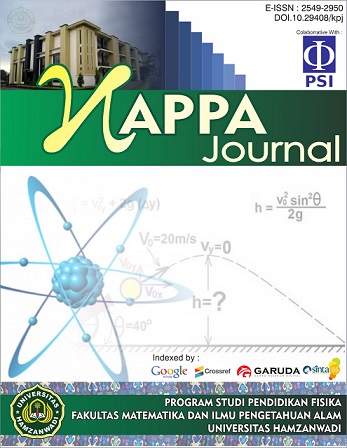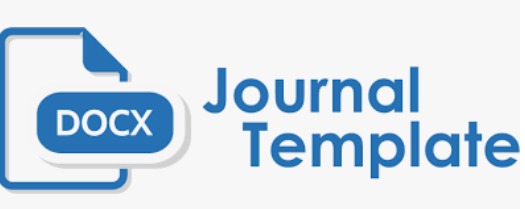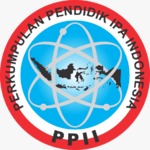Pengembangan Kemampuan Berpikir Kritis Peserta Didik SMA dengan Lembar Kerja Proses pada Mata Pelajaran Fisika
DOI:
https://doi.org/10.29408/kpj.v5i1.3371Keywords:
Critical thinking skills, LKPD, physicsAbstract
Student worksheets (LKPD) is the most significant aspect on the learning activities because it consists of the student’s learning process of gaining knowledge, primarily growing the critical thinking ability. The aim of the study is giving information about the development of critical thinking with LKPD process in physics subject. The method is Research and Development (RnD)-ADDIE which is limited on the development stage. Based on the evaluation result through validity which involve expert validity from the lecturer and the teacher, Content Validity Index (CVI) is 0,95 that means very suitable. The CVI result indicates that the LKPD process could be used to grow the physics critical thinking. The LKPD process has not arrived at implementation yet, hopefully the reseacher on the same field could apply till the implementation stage so that we could say LKPD process could grow the physics critical thinking.References
Apriyana, N., Herlina, K., & Abdurrahman, A. (2019). Pengembangan Lembar Kerja Siswa Berbasis Inkuiri Terbimbing untuk Meningkatkan Kemampuan Berpikir Kritis. Jurnal Pendidikan Fisika, 7(2), 92–96.
Astini, N. K. S. (2019). Pentingnya Literasi Teknologi Informasi Dan Komunikasi Bagi Guru Sekolah Dasar Untuk Menyiapkan Generasi Milenial. Prosiding Seminar Nasional Dharma Acarya, 1(2018), 113–120.
Cahyadi, R. A. H. (2019). Pengembangan Bahan Ajar Berbasis Addie Model. Halaqa: Islamic Education Journal, 3(1), 35–43. https://doi.org/10.21070/halaqa.v3i1.2124
Cockerill, S., Douglas, J., Gold, J., Stewart, G., & Hamilton, L. (1996). The international management of change : a learning / case study approach. Jurnal Education = Training, 38(2), 14–17.
Egen, P., & Kauchak, D. (2012). Strategie and Models for Teachers: Teaching Content and Thinking Skills (6 ed.). Boston: Pearson Education.
Ennis, R. H. (1985). A Logical Basis for Measuring Critical Thinking Skills. In Educational Leadership. https://pdfs.semanticscholar.org/80a7/c7d4a98987590751df4b1bd9adf747fd7aaa.pdf
Facione, P. a. (2011). Critical Thinking : What It Is and Why It Counts. In Insight assessment (Issue ISBN 13: 978-1-891557-07-1.). https://www.insightassessment.com/CT-Resources/Teaching-For-and-About-Critical-Thinking/Critical-Thinking-What-It-Is-and-Why-It-Counts/Critical-Thinking-What-It-Is-and-Why-It-Counts-PDF
Fitriyadi, H. (2013). Integrasi Teknologi Informasi Komunikasi Dalam Pendidikan : Potensi Manfaat , Masyarakat Berbasis Pengetahuan , Pendidikan Nilai , Strategi Implementasi Dan Pengembangan Profesional. Jurnal Pendidikan Teknologi Dan Kejuruan, 21(3), 269–284.
Huda, M. (2013). Model-Model Pengajaran dan Pembelajaran. Yogyakarta: Pustaka Belajar.
Lasmi, N. K. (2012). SPM Fisika SMA dan MA Siap Tuntas Menghadapi Ujian Nasional. Bandung: Esis.
Mclean, C. L. (2005). Evaluating Critical Thinking Skills : Two Conceptualizations. Journal of Distance Education Revue de L’Education a Distance Spring/Printemps, 20(2), 1–20.
Mukti, F., Connie, C., & Medriati, R. (2018). Pengembangan Lembar Kerja Peserta Didik (LKPD) Pembelajaran Fisika untuk Meningkatkan Kemampuan Berpikir Kreatif Siswa SMA Sint Carolus Kota Bengkulu. Jurnal Kumparan Fisika, 1(3), 57–63. https://doi.org/10.33369/jkf.1.3.57-63
Mulyadi, M., Wakhinuddin, W., & Fernandez, D. (2016). Meningkatkan Aktivitas Belajar Siswa Dengan Menggunakan Cooperative Learning Type Stad Pada Mata Pelajaran Dasar Otomotif Kelas X Otomotif Di Smk N 1 Sumbar. Jurusan Teknik Otomotif FT UNP, 9(10), 1–10.
Retnowati, D., Sujadi, I., & Subanti, S. (2016). Proses Berpikir Kritis Siswa Kelas XI Farmasi SMK Citra Medika Sragen dalam Pemecahan Masalah Matematika. Jurnal Elektronik Pembelajaran Matematika, 4(1), 105–116.
Rusman, R. (2014). Penerapan Pembelajaran Berbasis Masalah. Edutech, 13(2), 211. https://doi.org/10.17509/edutech.v13i2.3102
Sani, R. A. (2019). Pembelajaran Berbasis HOTS (Higher Order Thinking Skills) (1 ed.). Tangerang: Tira Smart.
Sukmadinata, N. S. (2003). Landasan Psikologi Proses Pendidikan (1 ed.). Bandung: PT Remaja Rosdakarya.
Susanti, S. (2016). Metode Mind Mapping Untuk Meningkatkan Hasil Belajar Ips Di Sekolah Dasar. Jurnal Pendidikan Guru Sekolah Dasar, 1(1), 25–37. https://doi.org/10.17509/jpgsd.v1i1.9060
Wahyuni, Y. (2017). Identifikasi Gaya Belajar ( Visual , Auditorial , Kinestetik) Mahasiswa Pendidikan Matematika Universitas Bung Hatta. Jppm, 10(2), 128–132. https://jurnal.untirta.ac.id/index.php/JPPM/article/view/2037
Wardani, M. I., & Suparno, S. (2016). Pengembangan Sistem Assessment Pembelajaran Materi Dinamika Partikel Berbasis Media Audio Visual Di Sma N 1 Pakem. Jurnal Pendidikan Fisika, 5(5), 329–336.









